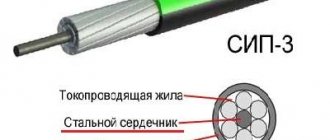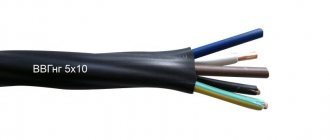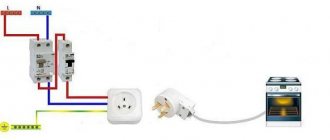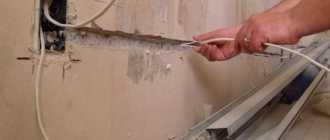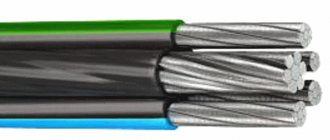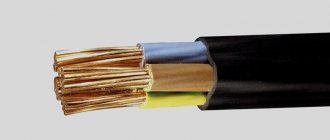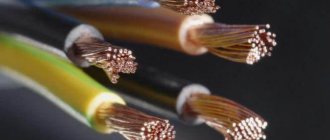When installing electrical wiring in an apartment or private house, it is very important to choose the correct wire cross-section. If you take a cable that is too thick, it will cost you a pretty penny, since its price directly depends on the diameter (section) of the conductors. The use of a thin cable leads to its overheating and if the protection does not work, the insulation may melt, a short circuit and, as a result, a fire. The most correct choice would be the wire cross-section depending on the load, which is reflected in the tables below.
Cable cross-section
The cable cross-section is the cut area of the current-carrying core. If the cut of the core is round (as in most cases) and consists of one wire, then the area/section is determined by the formula for the area of a circle. If there are many wires in the core, then the cross-section will be the sum of the cross-sections of all the wires in this core.
The cross-sectional values are standardized in all countries, and the standards of the former CIS and Europe in this part completely coincide. In our country, the document that regulates this issue is the “Rules for the Construction of Electrical Installations” or briefly - PUE.
The cable cross-section is selected based on the loads using special tables called “Permissible current loads on the cable.” If you have no desire to understand these tables, then it is enough for you to know that it is advisable to use a copper cable with a cross-section of 1.5-2.5 mm² for sockets, and 1.0-1.5 mm² for lighting.
To introduce one phase into an ordinary 2-3 room apartment, 6.0 mm² is quite enough. All the same, your 40-80 m² will not fit larger equipment, even taking into account the electric stove.
Many electricians, in order to “estimate” the required cross-section, believe that 1mm² of copper wire can pass 10A of electric current through itself: accordingly, 2.5 mm² of copper can pass 25A, and 4.0 mm² - 40A, etc. If you analyze the cable cross-section selection table a little, you will see that this method is only suitable for estimation and only for cables with a cross-section no higher than 6.0 mm².
Below is an abbreviated table for selecting cable cross-sections up to 35 mm² depending on current loads. For your convenience, the total power of electrical equipment is given there for 1-phase (220V) and 3-phase (380V) consumption.
When laying the cable in a pipe (i.e. in any closed spaces), the possible current loads on the cable should be less than when laying it openly. This is due to the fact that the cable heats up during operation, and heat transfer in a wall or in the ground is much lower than in open space.
When the load is called in kW, we are talking about the total load. Those. for a single-phase consumer, the load will be indicated for one phase, and for a three-phase consumer - in total for all three. When the load value is named in amperes (A), we are always talking about the load on one core (or phase).
Load table for cable cross-section:
| Cable cross-section, mm² | Laid open | Installed in a pipe | ||||||||||
| copper | aluminum | copper | aluminum | |||||||||
| current, A | power, kWt | current, A | power, kWt | current, A | power, kWt | current, A | power, kWt | |||||
| 220V | 380V | 220V | 380V | 220V | 380V | 220V | 380V | |||||
| 0.5 | 11 | 2.4 | ||||||||||
| 0.75 | 15 | 3.3 | ||||||||||
| 1 | 17 | 3.7 | 6.4 | 14 | 3 | 5.3 | ||||||
| 1.5 | 23 | 5 | 8.7 | 15 | 3.3 | 5.7 | ||||||
| 2.5 | 30 | 6.6 | 11 | 24 | 5.2 | 9.1 | 21 | 4.6 | 7.9 | 16 | 3.5 | 6 |
| 4 | 41 | 9 | 15 | 32 | 7 | 12 | 27 | 5.9 | 10 | 21 | 4.6 | 7.9 |
| 6 | 50 | 11 | 19 | 39 | 8.5 | 14 | 34 | 7.4 | 12 | 26 | 5.7 | 9.8 |
| 10 | 80 | 17 | 30 | 60 | 13 | 22 | 50 | 11 | 19 | 38 | 8.3 | 14 |
| 16 | 100 | 22 | 38 | 75 | 16 | 28 | 80 | 17 | 30 | 55 | 12 | 20 |
| 25 | 140 | 30 | 53 | 105 | 23 | 39 | 100 | 22 | 38 | 65 | 14 | 24 |
| 35 | 170 | 37 | 64 | 130 | 28 | 49 | 135 | 29 | 51 | 75 | 16 | 28 |
To independently calculate the required cable cross-section, for example, for entry into a house, you can use a cable calculator or select the required cross-section from the table.
This table applies to cables and wires with rubber and plastic insulation. These are such widespread brands as: PVS, GDP, VPP, PPV, APPV, VVG. AVVG and a number of others. Paper-insulated cables have their own table, and non-insulated wires and buses have their own.
When calculating the cable cross-section, the specialist must also take into account the methods of laying the cable: in trays, in bundles, etc.
- In addition, the values from the tables on permissible current loads must be adjusted by the following reduction factors:
- correction factor corresponding to the cable cross-section and its location in the block;
- correction factor for ambient temperature;
- correction factor for cables laid in the ground;
- correction factor for different numbers of operating cables laid nearby.
Selecting the cable cross-section according to power
You can select the wire cross-section according to the power of the devices that will be connected. These devices are called load and the method can also be called “by load”. Its essence does not change from this.
The choice of cable cross-section depends on the power and current
Collecting data
First, find the power consumption in the passport data of household appliances and write it down on a piece of paper. If it’s easier, you can look at nameplates - metal plates or stickers attached to the body of equipment and equipment. There is basic information and, more often than not, power. The easiest way to identify it is by its units of measurement. If a product is manufactured in Russia, Belarus, or Ukraine, it is usually designated W or kW; on equipment from Europe, Asia or America, the English designation for watts is usually W, and the power consumption (this is what is needed) is designated by the abbreviation “TOT” or TOT MAX.
Example of a nameplate with basic technical information. There is something similar on any technology
If this source is also unavailable (the information has become lost, for example, or you are just planning to purchase equipment, but have not yet decided on the model), you can take the average statistical data. For convenience, they are summarized in a table.
Table of power consumption of various electrical appliances
Find the equipment you plan to install and write down the power. Sometimes it is given with a wide spread, so sometimes it is difficult to understand which figure to take. In this case, it is better to take the maximum. As a result, when calculating, you will slightly overestimate the power of the equipment and will need a cable with a larger cross-section. But for calculating the cable cross-section it is good. Only cables with a smaller cross-section than necessary will burn. Routes with a large cross-section work for a long time, as they heat up less.
The essence of the method
To select the wire cross-section for the load, add up the power of the devices that will be connected to this conductor
It is important that all powers are expressed in the same units of measurement - either in watts (W) or in kilowatts (kW). If there are different values, we bring them to a single result
To convert, kilowatts are multiplied by 1000 to get watts. For example, let's convert 1.5 kW into watts. This will be 1.5 kW * 1000 = 1500 W.
If necessary, you can carry out the reverse conversion - convert watts to kilowatts. To do this, divide the figure in watts by 1000 to get kW. For example, 500 W / 1000 = 0.5 kW.
Next, the selection of the cable cross-section actually begins. It's very simple - we use a table.
| Cable cross-section, mm2 | Conductor diameter, mm | Copper wire | Aluminum wire | ||||
| Current, A | power, kWt | Current, A | power, kWt | ||||
| 220 V | 380 V | 220 V | 380 V | ||||
| 0.5 mm2 | 0.80 mm | 6 A | 1.3 kW | 2.3 kW | |||
| 0.75 mm2 | 0.98 mm | 10 A | 2.2 kW | 3.8 kW | |||
| 1.0 mm2 | 1.13 mm | 14 A | 3.1 kW | 5.3 kW | |||
| 1.5 mm2 | 1.38 mm | 15 A | 3.3 kW | 5.7 kW | 10 A | 2.2 kW | 3.8 kW |
| 2.0 mm2 | 1.60 mm | 19 A | 4.2 kW | 7.2 kW | 14 A | 3.1 kW | 5.3 kW |
| 2.5 mm2 | 1.78 mm | 21 A | 4.6 kW | 8.0 kW | 16 A | 3.5 kW | 6.1 kW |
| 4.0 mm2 | 2.26 mm | 27 A | 5.9 kW | 10.3 kW | 21 A | 4.6 kW | 8.0 kW |
| 6.0 mm2 | 2.76 mm | 34 A | 7.5 kW | 12.9 kW | 26 A | 5.7 kW | 9.9 kW |
| 10.0 mm2 | 3.57 mm | 50 A | 11.0 kW | 19.0 kW | 38 A | 8.4 kW | 14.4 kW |
| 16.0 mm2 | 4.51 mm | 80 A | 17.6 kW | 30.4 kW | 55 A | 12.1 kW | 20.9 kW |
| 25.0 mm2 | 5.64 mm | 100 A | 22.0 kW | 38.0 kW | 65 A | 14.3 kW | 24.7 kW |
To find the required cable cross-section in the corresponding column - 220 V or 380 V - we find a figure that is equal to or slightly greater than the power we previously calculated. We select the column based on how many phases are in your network. Single-phase - 220 V, three-phase 380 V.
In the found line, look at the value in the first column. This will be the required cable cross-section for a given load (power consumption of devices). You will need to look for a cable with cores of this cross-section.
A little about whether to use copper wire or aluminum. In most cases, when laying wiring in a house or apartment, cables with copper conductors are used. Such cables are more expensive than aluminum ones, but they are more flexible, have a smaller cross-section, and are easier to work with. But copper cables with a large cross-section are no more flexible than aluminum ones. And under heavy loads - at the entrance to a house or apartment with a large planned power (from 10 kW or more), it is more advisable to use a cable with aluminum conductors - you can save a little.
Calculation of wire cross-section
Let's start not with a table, but with a calculation. That is, each person, without having the Internet at hand, where the PUE with tables is freely available, can independently determine the cable cross-section by current. To do this you will need a caliper and a formula.
If we consider the cross-section of the cable, it is a circle with a certain diameter. There is a formula for the area of a circle: S = 3.14*D²/4, where 3.14 is the Archimedean number, “D” is the diameter of the measured core. The formula can be simplified: S=0.785*D².
If the wire consists of several cores, then the diameter of each is measured, the area is calculated, then all the indicators are summed up. How to calculate the cross-section of a cable if each core consists of several thin wires?
The process becomes a little more complicated, but not much. To do this, you will have to count the number of wires in one core, measure the diameter of one wire, calculate its area using the described formula and multiply this figure by the number of wires. This will be the cross section of one core. Now you need to multiply this value by the number of cores.
If you don’t want to count the wires and measure their sizes, you just need to measure the diameter of one core, consisting of several wires. You must take measurements carefully so as not to crush the core. Please note that this diameter is not exact because there is space between the wires.
Relation between current and cross section
To understand how an electrical cable works, you need to remember a regular water pipe. The larger its diameter, the more water will pass through it. It's the same with wires.
The larger their area, the greater the current that will pass through them, the greater the load such a wire can withstand. In this case, the cable will not overheat, which is the most important requirement of fire safety rules.
Therefore, the cross-section - current connection is the main criterion that is used in the selection of electrical wires in the wiring. Therefore, you need to first figure out how many household appliances and what total power will be connected to each loop.
| Wire core cross-section, mm2 | Copper conductors | Aluminum conductors | ||
| Current, A | Power, W | Current, A | Power, W | |
| 0.5 | 6 | 1300 | ||
| 0.75 | 10 | 2200 | ||
| 1 | 14 | 3100 | ||
| 1.5 | 15 | 3300 | 10 | 2200 |
| 2 | 19 | 4200 | 14 | 3100 |
| 2.5 | 21 | 4600 | 16 | 3500 |
| 4 | 27 | 5900 | 21 | 4600 |
| 6 | 34 | 7500 | 26 | 5700 |
| 10 | 50 | 11000 | 38 | 8400 |
| 16 | 80 | 17600 | 55 | 12100 |
| 25 | 100 | 22000 | 65 | 14300 |
For example, the kitchen must have a refrigerator, microwave, coffee grinder and coffee maker, an electric kettle and sometimes a dishwasher. That is, all these devices can be turned on simultaneously at the same time. Therefore, the total power of the room is used in the calculations.
You can find out the power consumption of each device from the product passport or on the tag.
- For example, let's designate some of them:
- Kettle – 1-2 kW.
- Microwave and meat grinder 1.5-2.2 kW.
- Coffee grinder and coffee maker – 0.5-1.5 kW.
- Refrigerator 0.8 kW.
Having found out the power that will act on the wiring, you can select its cross-section from the table. We will not consider all the indicators in this table; we will show those that prevail in everyday life.
Before purchasing any wire or cable, you first calculate its cross-section and only then go to the store. Ask the seller to give you a good cable, and that its cross-section corresponds to GOST, and not some kind of fake. Right?
Why do cables of the same section have different core diameters?
Let's first define some terminology.
The nominal cross-section of the conductor is the cross-sectional area of the current-carrying conductor, indicated in the marking of the cable product. That is, these are the numbers that you read on the cable tag or on its insulation.
The actual cross-section of the conductor is the cross-sectional area of the conductor, determined by measurements. This is when you use a caliper to measure the diameter of the core and then calculate its area.
We've sorted that out, let's move on.
When producing cables and wires, factories must adhere to GOST 22483-2012 “Current-carrying conductors for cables, wires and cords.” Let's trust that manufacturers adhere to these standards. I sleep better this way.
This document states that conductive conductors must meet only one basic parameter - electrical resistance to direct current. There are standards that should not exceed 1 kilometer of core at 200C. The table below shows these values of some popular sections.
| Nominal core cross-section, mm2 | Electrical resistance to direct current of 1 km of core at 200C, Ohm, no more | |
| Copper conductors | Aluminum conductors | |
| 0,75 | 24,5 | — |
| 1,0 | 18,1 | — |
| 1,5 | 12,1 | 18,1 |
| 2,5 | 7,41 | 12,1 |
| 4,0 | 4,61 | 7,41 |
| 6,0 | 3,08 | 5,11 |
| 10,0 | 1,83 | 3,08 |
| 16,0 | 1,15 | 1,91 |
| 25,0 | 0,727 | 1,2 |
This GOST does not strictly standardize the nominal cross-section of the cable cores. It is written there:
“For each specific core size there is a requirement for the maximum value of electrical resistance. The actual cross-section of the conductors may differ from the nominal one if the electrical resistance meets the requirements of this standard.”
However, there is a table that shows the maximum diameter of the cores for each section. As you can see, it is possible to reduce the diameter, and therefore the cross-section.
| Nominal core cross-section, mm2 | Diameter of round copper cores, mm, no more | |
| Class 1 wires (solid wire) | Class 2 wires (stranded) | |
| 0,75 | 1,0 | 1,2 |
| 1,0 | 1,2 | 1,4 |
| 1,3 | 1,5 | 1,7 |
| 2,5 | 1,9 | 2,2 |
| 4,0 | 2,4 | 2,7 |
| 6,0 | 2,9 | 3,3 |
| 10,0 | 3,7 | 4,2 |
| 16,0 | 4,6 | 5,3 |
| 25,0 | 5,7 | 6,6 |
So this is why it turns out that the actual cross-section of the cores (measured by you) may differ from the nominal one (indicated on the tag). There is essentially nothing wrong with this if the manufacturer has not exceeded the normalized value of electrical resistance to direct current. Unfortunately, you cannot check this parameter in the store. Of course, if the measured cross-section is much smaller than the nominal one, then it is better to refrain from purchasing such a cable.
Why then are the diameters of the wires different with the same electrical resistance of the conductor?
This largely depends on the material and the manufacturing process itself. We think that copper is copper in Africa too. Not really. Copper comes in different grades, and the production of wires has different technological processes.
Various technologies make it possible to withstand electrical resistance, but at the same time reduce the cost of cable manufacturing, by reducing the actual cross-section and deteriorating the purification of copper from various impurities. Try checking the wires with a magnet at home in some cheap Chinese device. I wouldn't be surprised if they were attracted to a magnet, as I've seen that happen. Copper and aluminum are not magnetic, which is why they contain cheap steel alloys.
As you can see, reducing the actual cross-section of the cores is permitted by GOST. So it all comes down to the conscience of the manufacturer, i.e. this is done legally. And we know that their conscience is clear and transparent, that it cannot be seen. Especially from Chinese manufacturers.
Don't forget to smile:
During the operation the lights go out. - Doctor, we are losing him! We're losing! That's it, we've lost... - It's okay, now the electricians will fix the light and then we'll find it. It won't crawl far. He's under anesthesia. Moreover, I already made the cut...
What is the difference between a cable and a wire?
Before moving on to the main content, we need to understand what we still want to calculate, the cross-section of a wire or cable, what are the differences between one and the other!? Despite the fact that the average person uses these two words as synonyms, meaning by this something of their own, but if we are meticulous, there is still a difference.
So a wire is one conductive core, be it a single core or a set of conductors, insulated into a dielectric, into a sheath. But a cable is already several such wires combined into a single whole, in its own protective and insulating sheath. In order for you to better understand what's what, take a look at the picture.
So, now we know that we need to calculate exactly the cross-section of the wire, that is, one conductive element, and the second will already move away from the load, back to the power supply.
However, sometimes we ourselves forget ourselves no better than you, so if you catch us by the fact that somewhere you still come across the word cable, then do not consider it ignorance, stereotypes do their job.
Cable selection
It is best to make internal wiring using copper wires. Although aluminum ones are not inferior to them. But there is one nuance here, which is associated with the correct connection of sections in the distribution box. As practice shows, connections often fail due to oxidation of the aluminum wire.
Another question is which wire to choose: single-core or stranded? Single-core has better current conductivity, so it is recommended for use in household electrical wiring. Multicore has high flexibility, which allows it to be bent in one place several times without compromising quality.
Single or stranded
When installing electrical wiring, wires and cables of the PVS, VVGng, PPV, APPV brands are usually used. This list contains both flexible cables and monocore cables.
Here we would like to tell you one thing. If your wiring will not move, that is, it is not an extension cord, or a bend point that constantly changes its position, then it is preferable to use a monocore.
You will ask why? It's simple! No matter how well the conductors are laid in the protective insulating braid, air containing oxygen will still get under it. Oxidation of the copper surface occurs.
As a result, if there are many conductors, then the oxidation area is much larger, which means the current-carrying cross-section “melts” much more. Yes, this is a long process, but we don’t think that you are going to change the wiring often. The more she works, the better.
This oxidation effect will be especially pronounced at the edges of the cable cut, in rooms with temperature changes and high humidity. So we strongly recommend that you use monocore! The cross-section of a monocore cable or wire will change slightly over time, and this is so important for our further calculations.
Copper or aluminum
In the USSR, most residential buildings were equipped with aluminum wiring; this was a kind of norm, standard, and even dogma. No, this does not mean at all that the country was poor and there was a shortage of copper. Even in some cases it's the other way around.
But apparently the designers of electrical networks decided that they could save a lot economically if they used aluminum rather than copper. Indeed, the pace of construction was enormous; just remember the Khrushchev buildings, in which half of the country still lives, which means the effect of such savings was significant. There is no doubt about this.
However, today the realities are different, and aluminum wiring is not used in new residential premises, only copper. This is based on the rules of the PUE, clause 7.1.34 “Cables and wires with copper conductors should be used in buildings...”.
So, we strongly do not recommend that you experiment and try aluminum. Its disadvantages are obvious. Aluminum strands cannot be soldered and are also very difficult to weld; as a result, the contacts in the junction boxes may break over time. Aluminum is very fragile, two or three bends and the wire falls off.
There will be constant problems connecting it to sockets and switches. Again, if we talk about conducted power, then a copper wire with the same cross-section for aluminum is 2.5 mm2. allows a continuous current of 19A, and for copper 25A. Here the difference is more than 1 kW.
So let’s repeat it again - only copper! Further, we will proceed from the fact that we are calculating the cross-section for a copper wire, but in the tables we will also give values for aluminum. You never know.
Table of ratios of diameters and sections
Determining the cross-sections of cables and wires using formulas is considered a rather labor-intensive and complex process that does not guarantee an accurate result. For these purposes, there is a special ready-made table, the diameter and cross-section of the wire in which clearly represents their relationship. For example, with a conductor diameter of 0.8 mm, its cross-section will be 0.5 mm. A diameter of 1 mm corresponds to a cross-section of 0.75 mm, and so on. It is enough just to measure the diameter of the wire, and then look at the table and calculate the required cross-section.
When performing calculations, you must follow certain recommendations. To determine the cross-section, it is necessary to use a wire that is completely stripped of insulation. This is due to the possible reduced dimensions of the cores and a higher insulating layer. If there is any doubt about the size of the cable, it is recommended to purchase a conductor with a higher cross-section and power reserve. In the case of determining the cross-section of a multi-core cable, the diameters of individual wires are first calculated, the resulting values are summed up and used in a formula or table.
Why is the calculation made?
Wires and cables that carry electrical current are the most important part of electrical wiring.
The wire cross-section must be calculated to ensure that the selected wire meets all the requirements for reliability and safe operation of electrical wiring.
Safe operation is that if you choose a cross-section that does not correspond to its current loads, this will lead to excessive overheating of the wire, melting of the insulation, short circuit and fire.
Therefore, the issue of choosing a wire cross-section must be taken very seriously.
What you need to know
The main indicator by which a wire is calculated is its long-term permissible current load. Simply put, this is the amount of current that it is capable of passing for a long time.
To find the rated current value, you need to calculate the power of all connected electrical appliances in the house. Let's consider an example of calculating the wire cross-section for an ordinary two-room apartment.
Table of power/current consumption of household electrical appliances
| electrical appliance | Power consumption, W | Current strength, A |
| Washing machine | 2000 – 2500 | 9,0 – 11,4 |
| Jacuzzi | 2000 – 2500 | 9,0 – 11,4 |
| Electric floor heating | 800 – 1400 | 3,6 – 6,4 |
| Stationary electric stove | 4500 – 8500 | 20,5 – 38,6 |
| microwave | 900 – 1300 | 4,1 – 5,9 |
| Dishwasher | 2000 – 2500 | 9,0 – 11,4 |
| Freezers, refrigerators | 140 – 300 | 0,6 – 1,4 |
| Electric meat grinder | 1100 – 1200 | 5,0 – 5,5 |
| Electric kettle | 1850 – 2000 | 8,4 – 9,0 |
| Electric coffee maker | 630 – 1200 | 3,0 – 5,5 |
| Juicer | 240 – 360 | 1,1 – 1,6 |
| Toaster | 640 – 1100 | 2,9 – 5,0 |
| Mixer | 250 – 400 | 1,1 – 1,8 |
| Hairdryer | 400 – 1600 | 1,8 – 7,3 |
| Iron | 900 –1700 | 4,1 – 7,7 |
| Vacuum cleaner | 680 – 1400 | 3,1 – 6,4 |
| Fan | 250 – 400 | 1,0 – 1,8 |
| TV | 125 – 180 | 0,6 – 0,8 |
| Radio equipment | 70 – 100 | 0,3 – 0,5 |
| Lighting devices | 20 – 100 | 0,1 – 0,4 |
Once the power is known, the calculation of the cross-section of a wire or cable comes down to determining the current strength based on this power. You can find the current strength using the formula:
1) Formula for calculating current for a single-phase 220 V network:
current calculation for a single-phase network
where P is the total power of all electrical appliances, W; U—mains voltage, V; CI = 0.75 - simultaneity coefficient; cos for household electrical appliances - for household electrical appliances. 2) Formula for calculating the current in a three-phase 380 V network:
current calculation for a three-phase network
Knowing the magnitude of the current, the wire cross-section is found from the table. If it turns out that the calculated and tabulated current values do not coincide, then in this case the nearest larger value is selected. For example, the calculated current value is 23 A, we select the nearest larger one from the table, 27 A - with a cross-section of 2.5 mm2.
Which wire is better to use
Today, for installation of both open and hidden electrical wiring, copper wires are, of course, very popular.
- Copper, compared to aluminum, is more effective:
- it is stronger, softer and does not break in places of inflection compared to aluminum;
- less susceptible to corrosion and oxidation. When connecting aluminum in a junction box, the twist points oxidize over time, which leads to loss of contact;
- The conductivity of copper is higher than that of aluminum; with the same cross-section, a copper wire can withstand a higher current load than aluminum.
The disadvantage of copper wires is their high cost. Their cost is 3-4 times higher than aluminum ones. Although copper wires are more expensive, they are still more common and popular in use than aluminum wires.
Calculation of the cross-section of copper wires and cables
Having calculated the load and decided on the material (copper), let’s consider an example of calculating the cross-section of wires for individual groups of consumers, using the example of a two-room apartment.
As you know, the entire load is divided into two groups: power and lighting.
In our case, the main power load will be the socket group installed in the kitchen and bathroom. Since the most powerful equipment is installed there (electric kettle, microwave, refrigerator, boiler, washing machine, etc.).
For this socket group we select a wire with a cross section of 2.5mm2. Provided that the power load will be scattered across different outlets. What does it mean? For example, in the kitchen, to connect all household appliances, you need 3-4 sockets connected with copper wire with a cross-section of 2.5 mm2 each.
If all equipment is connected through one single socket, then a cross-section of 2.5 mm2 will not be enough, in this case you need to use a wire with a cross-section of 4-6 mm2. In living rooms, a wire with a cross section of 1.5 mm2 can be used to power sockets, but the final choice must be made after appropriate calculations.
The entire lighting load is powered by a wire with a cross section of 1.5 mm2.
It is necessary to understand that the power in different sections of the electrical wiring will be different, and accordingly the cross-section of the supply wires will also be different. Its greatest value will be in the introductory section of the apartment, since the entire load passes through it. The cross-section of the input supply wire is selected 4 - 6 mm2.
When installing electrical wiring, wires and cables of the PVS, VVGng, PPV, APPV brands are used.
Selection of cable cross-section by power
Now we get to the essence of our article. However, everything that was above cannot be missed, which means we could not remain silent.
If we try to present the idea logically and simply, then a current of a certain strength can pass through each conventional cross-section of a conductor. This conclusion is quite logical and now all that remains is to find out these ratios and correlate them for different wire diameters, based on its type series.
It also cannot be ignored that here, when calculating the current cross section, temperature also comes into play. Yes, this is a new component – temperature. It is she who can influence the cross section. How and why, let's figure it out.
We all know about Brownian motion. On the constant displacement of ions in a crystal lattice. All this happens in all materials, including conductors. The higher the temperature, the greater these vibrations of ions within the material will be. And we know that current is the directed movement of particles.
So, the directed movement of particles will collide with ions in the crystal lattice, which will lead to an increase in resistance to current.
The higher the temperature, the higher the electrical resistance of the conductor. Therefore, by default, the wire cross-section for a certain current is taken at room temperature, that is, at 18 degrees Celsius. It is at this temperature that all reference values are given in the tables, including ours.
Despite the fact that we do not consider aluminum wires as wires for electrical wiring, at least in an apartment, they are nevertheless used in many places. Let's say for wiring on the street. That is why we will also present the values of the cross-section and current dependencies for aluminum wires.
So, for copper and aluminum there will be the following indicators of the dependence of the cross-section of the wire (cable) on the current (power). See table.
Table of conductors for maximum permissible current for their use in wiring:
Since 2001, aluminum wires have not been used for wiring in apartments. (PEU)
Yes, here, as our reader noted, we actually did not provide calculations, but only provided reference data, tabulated, based on these calculations. But we dare to tell you that for calculations it is necessary to go through many formulas and indicators. Starting from temperature, resistivity, current density and the like.
Therefore, we will leave such calculations for specialists. It should be noted that they are not final, since they may vary slightly depending on the standard for the material and the current reserve of the wire used in different countries.
But what we would also like to talk about is converting the wire cross-section to diameter. This is necessary when there is a wire, but for some reason there is no marking on it. In this case, the cross-section can be calculated from the diameter of the wire, and vice versa from the diameter of the cross-section.
How to calculate the wire cross-section?
The cross-sectional areas of the cores are standardized. Their values are selected based on the current strength, core material and laying conditions. After all, when operating the cable to the limit of its capabilities, the cores will heat up by several tens of degrees.
And if several such cables are laid in one tray, then with mutual heating of the products, the permissible current will decrease to 30%.
To correctly calculate the wire cross-section that is best suited for home lines, you need to calculate the total current value of all household electrical appliances
The calculation is done using the following formula: P/V.
Where:
- P – power of devices, the parameters of which are indicated in the technical documentation;
- V – mains voltage 220 V.
The cross-sectional area is measured in square millimeters. Thus, one “square” of aluminum wire is capable of passing through itself from 4 to 6 Amperes. For the copper analogue, this parameter reaches 10 Amps.
For example, for an electrical appliance with a power of 4 kilowatts, according to this formula, the current becomes equal to 18.18 A = 4000 W/200V. To power such a device, you will need to lay wiring with copper threads with a cross-section of 1.8 mm2.
As a safety net, it is better to additionally multiply the resulting value by 1.5. Therefore, the most ideal option for powering such a powerful device is a copper wire with a cross-section of 2 mm2. If we consider the option of installing an aluminum analogue, then you will need a cord whose thickness is 2.5 times greater.
The table below will help simplify the task of calculating the wire cross-section.
A table that is convenient to use when calculating the wire cross-section for a home highway, taking into account the current value of all powered electrical appliances
Important point! When designing hidden wiring, the data from the table must be multiplied by a factor of 0.8.
If open, it is capable of installation in the same private house; in any case, for reliability, it is better to use a wire with a cross-section of 4 mm2 and higher, giving preference to products with high mechanical strength.
In terms of the cross-sectional plane, the installation cable for entry into the house should be one step higher than that required for servicing the most installed electrical appliances.
To save money, such a wire can be used only for entering the house and connecting it to the terminal block, and through the machines the lines of the required cross-section can be routed.
According to the requirements of PUE PUE 7.1.34, each line must be calculated separately with a focus on a specific load. However, there are options with standard cross-sectional sizes that are acceptable for all residential properties:
Common cross-sections for wiring in an apartment
We talked a lot about names, materials, individual characteristics and even temperature, but we lost sight of life circumstances.
So, if you hire an electrician to conduct wiring in the rooms of your apartment or house, then the following values are usually accepted. For lighting, the wire cross-section is taken at 1.5 mm 2, and for sockets at 2.5 mm 2.
If the wiring is intended for connecting boilers, heaters, stoves, then the cross-section of the wire (cable) is already calculated individually.
Selecting the wire cross-section based on the number of consumers
What I also wanted to say is that it is better to use several independent power lines for each room in a room or apartment. Thus, you will not use a wire with a cross-section of 10 mm 2 for the entire apartment, routed to all rooms, from which there are taps.
Such a wire will come to the input machine, and then from it, in accordance with the power of the consumed load, selected wire sections will be routed for each of the rooms.
Typical electrical wiring diagram for an apartment or house with an electric stove (indicating the cable cross-section for electrical appliances)
Current loads in DC networks
In networks with direct current, the cross section is calculated somewhat differently. The resistance of a conductor to direct voltage is much higher than to alternating current (with alternating current, resistance at lengths of up to 100 m is generally neglected).
In addition, for DC consumers, as a rule, it is very important that the voltage at the ends is not lower than 0.5V (for AC consumers, as is known, voltage fluctuations within 10% in any direction are acceptable).
There is a formula that determines how much the voltage at the ends will drop compared to the base voltage, depending on the length of the conductor, its resistivity and the current in the circuit:
U = ((pl)/S)I
- Where:
- U—DC voltage, V
- p—wire resistivity, Ohm*mm2/m
- l — wire length, m
- S - cross-sectional area, mm2
- I - current strength, A
Knowing the values of these indicators, it is quite easy to calculate the cross section you need: by substitution method, or using simple arithmetic operations on this equation.
If the DC voltage drop at the ends does not matter, then to select the cross-section you can use the table for alternating current, but at the same time adjust the current values by 15% towards a decrease, i.e. with direct current, reference cable cross-sections can carry 15% less current than indicated in the table.
A similar rule also works for selecting circuit breakers for networks with direct current, for example: for circuits with a load of 25A, you need to take a circuit breaker with a 15% lower rating; in our case, the previous standard size of the circuit breaker is suitable - 20A.
The cable that transmits electric current is one of the most important elements of the electrical network. If the cable fails, the operation of the entire system becomes impossible, therefore, to prevent failures, as well as the risk of fire from overheating, an accurate calculation of the cable cross-section for the load should be made.
This calculation gives confidence in the safe and reliable operation of the network and devices, but more importantly, the safety of people.
Choosing a cross-section that is insufficient for the current load leads to overheating, melting and damage to the insulation, and this, in turn, leads to a short circuit and even a fire. So there are many reasons to carry out calculations and carefully select the appropriate cable.
What is needed for load calculations
The main indicator that helps calculate the cross-section and brand of cable is the maximum permissible continuous load (current). To put it simply, this is the amount of current that the cable is capable of passing under the conditions of its installation without overheating for a sufficiently long time.
This requires a simple arithmetic summation of the powers of all electrical appliances that will be connected to the network.
The next important step to achieve safety is to calculate the cable cross-section for the load, for which it is necessary to calculate the current strength using the formula:
For a single-phase 220 V network:
- Where:
- P is the total power for all electrical appliances, W;
- U—mains voltage, V;
- COSφ - power factor.
For a three-phase network with a voltage of 380 V:
| Device name | Approximate power, W |
| LCD TV | 140-300 |
| Fridge | 300-800 |
| Vacuum cleaner | 800-2000 |
| Computer | 300-800 |
| Electric kettle | 1000-2000 |
| Air conditioner | 1000-3000 |
| Lighting | 300-1500 |
| Microwave | 1500-2200 |
Having received the exact current value, you should refer to tables that allow you to find a cable or wire of the required cross-section and material. But if the obtained current value does not exactly coincide with the table value, then you should not “save”, but rather choose the nearest, but larger value of the cable cross-section.
Example: with a network voltage of 220 V, the resulting current value was 22 amperes, the nearest larger value (27 A) is a copper wire or copper cable with a cross-section of 2.5 mm square. This means that the optimal choice would be just such a cable, and not with a cross-section of 1.5 mm square, which has a permissible continuous current of 19 A.
| Cross-section of current-carrying conductors, mm | Copper conductors of wires and cables | |||
| Voltage 220V | Voltage 380V | |||
| Current, A | power, kWt | Current, A | power, kWt | |
| 1,5 | 19 | 4,1 | 16 | 10,5 |
| 2,5 | 27 | 5,9 | 25 | 16,5 |
| 4 | 38 | 8,3 | 30 | 19,8 |
| 6 | 46 | 10,1 | 40 | 26,4 |
| 10 | 70 | 15,4 | 50 | 33 |
| 16 | 85 | 18,7 | 75 | 49,5 |
| 25 | 115 | 25,3 | 90 | 59,4 |
| 35 | 135 | 29,7 | 115 | 75,9 |
| 50 | 175 | 38,5 | 145 | 95,7 |
| 70 | 215 | 47,3 | 180 | 118,8 |
| 95 | 260 | 57,2 | 220 | 145,2 |
| 120 | 300 | 66 | 260 | 171,6 |
If you choose a cable with aluminum cores, then it is better to take a core cross-section of 4 mm square rather than 2.5.
| Cross-section of current-carrying conductors, mm | Aluminum conductors of wires and cables | |||
| Voltage 220V | Voltage 380V | |||
| Current, A | power, kWt | Current, A | power, kWt | |
| 2,5 | 20 | 4,4 | 19 | 12,5 |
| 4 | 28 | 6,1 | 23 | 15,1 |
| 6 | 36 | 7,9 | 30 | 19,8 |
| 10 | 50 | 11 | 39 | 25,7 |
| 16 | 60 | 13,2 | 55 | 36,3 |
| 25 | 85 | 18,7 | 70 | 46,2 |
| 35 | 100 | 22 | 85 | 56,1 |
| 50 | 135 | 29,7 | 110 | 72,6 |
| 70 | 165 | 36,3 | 140 | 92,4 |
| 95 | 200 | 44 | 170 | 112,2 |
| 120 | 230 | 50,6 | 200 | 132 |
Formula for wire cross-section by diameter
So, I would like to summarize all of the above. If there are those among you who did not read the article before this paragraph, but simply skipped over, I repeat. Cable and conductor products often lack information about the standards according to which they were manufactured. Ask the seller, according to GOST or TU. Sellers sometimes cannot answer this question themselves.
We can safely say that wires manufactured according to specifications in 99.9% of cases have not only a reduced cross-section of current-carrying conductors (by 10-30%), but also a lower permissible current. Also in such products you will find thin external and internal insulation.
If you have visited all the stores and have not found any wires produced in accordance with GOST, then take a wire with a reserve of +1 (if it is produced in accordance with the technical specifications). For example, you need a 1.5 sq.m. wire. mm., then you should take 2.5 sq. mm. (released by TU). In practice, its cross-section will be equal to 1.7-2.1 square meters. mm.
Thanks to the cross-sectional reserve, a current reserve will be provided, that is, the load may be slightly exceeded. So much the better for you. If you need a wire with a cross-section of 2.5 sq. mm., then take one with a cross section of 4 sq. mm., since its actual cross-section will be equal to 3 sq. mm.
So let's get back to our question. The conductor has a cross section in the form of a circle. Surely, you remember that in geometry the area of a circle is calculated using a specific formula. It is enough to substitute the resulting diameter value into this formula. After making all the calculations, you will get the wire cross-section.
- π is a constant in mathematics equal to 3.14;
- R is the radius of the circle;
- D is the diameter of the circle.
This is the formula for calculating the cross-section of a wire by diameter, which many people are afraid of for some reason. For example, you measured the core diameter and got a value of 1.8 mm. Substituting this number into the formula, we get the following expression: (3.14/4)*(1.8)2=2.54 sq. mm. This means that the wire whose core diameter you measured has a cross-section of 2.5 sq. mm.
Calculation of a monolithic core
When you go to the store to buy wire, take a micrometer or caliper with you. The latter is more common as a wire cross-section measuring device.
I’ll say right away that calculate the cable cross-section by diameter for the VVGng 3*2.5 mm2 cable from three different manufacturers. That is, the essence of all the work will be divided into three stages (this is only for monolithic wire). Let's see what happens.
To find out the cross-section of a wire (cable) consisting of one wire (solid core), you need to take a regular caliper or micrometer and measure the diameter of the wire core (without insulation).
To do this, you need to first clear a small section of the wire being measured from insulation, and then begin measuring the current-carrying conductor. In other words, we take one core and remove the insulation, and then measure the diameter of this core with a caliper.
Example No. 1. Cable VVG-Png 3*2.5 mm2 (manufacturer unknown). The general impression was that the cross-section immediately seemed too small, so I took it for experiment.
We remove the insulation and measure with a caliper. I got a core diameter of 1.5 mm. (not enough though).
Now we return to our formula described above and substitute the obtained data into it.
We have:
It turns out that the actual cross-section is 1.76 mm2 instead of the declared 2.5 mm2.
Example No. 2. Cable VVG-Png 3*2.5 mm2 (). The general impression is that the cross-section seems to be normal, the insulation is also good, it looks dense and they didn’t skimp on materials.
We do everything in the same way, remove the insulation, measure, we get the following numbers: diameter - 1.7 mm.
We substitute into our formula for calculating the cross-section by diameter , we get:
The actual cross-section is 2.26 mm2.
Example No. 3. So the last example left is cable VVG-Png 3*2.5 mm2, manufacturer unknown. The general impression is that the cross-section also seemed underestimated; the insulation is generally removed with bare hands (no strength at all).
This time the core diameter was 1.6 mm.
The actual cross-section is 2.00 mm2.
I would also like to add to today’s manual how to determine the cross-section of a wire by diameter using a caliper, another example, VVG 2*1.5 cable (I just had a piece lying around). I just wanted to compare, the sections of the 1.5 format are also underestimated.
We do the same thing: remove the insulation, take a caliper. The resulting core diameter was 1.2 mm.
The actual cross-section is 1.13 mm2 (instead of the stated 1.5 mm2).
Calculation without calipers
This calculation method is used to find the cross-section of a wire with one core. In this case, no measuring instruments are used. Undoubtedly, the use of a caliper or micrometer for these purposes is considered the most optimal. But these tools are not always available.
In this case, find a cylindrical object. For example, a regular screwdriver. We take any core in the cable, the length is arbitrary. We remove the insulation so that the core is completely clean. We wrap the exposed wire around a screwdriver or a pencil. The more turns you make, the more accurate the measurement will be.
All turns should be positioned as closely as possible to each other so that there are no gaps. We count how many turns we got. I counted 16 turns. Now you need to measure the length of the winding. I got 25 mm. Divide the length of the winding by the number of turns.
- L—winding length, mm;
- N is the number of complete turns;
- D is the diameter of the core.
The resulting value is the diameter of the wire. To find the cross section, we use the formula described above. D = 25/16 = 1.56 mm2. S = (3.14/4)*(1.56)2 = 1.91 mm2. It turns out that when measured with a caliper, the cross section is 1.76 mm2, and when measured with a ruler, it is 1.91 mm2 - well, an error is an error.
How to determine the cross-section of a stranded wire
The calculation is based on the same principle. But if you measure the diameter of all the wires that make up the core at once, you will calculate the cross-section incorrectly, because there is an air gap between the wires.
Therefore, you first need to fluff up the core of the wire (cable) and count the number of wires. Now, using the method described above, it is necessary to measure the diameter of one vein.
For example, we have a wire consisting of 27 cores. Knowing that the diameter of one vein is 0.2 mm, we can determine the cross-section of this vein using the same expression to calculate the area of a circle. The resulting value must be multiplied by the number of veins in the bundle. This way you can find out the cross-section of the entire stranded wire.
As a stranded wire, PVA 3*1.5. There are 27 individual wires in one wire. We take a caliper and measure the diameter, I got a diameter of 0.2 mm.
Now we need to determine the cross section of this vein; for this we use the same formula. S1 = (3.14/4)*(0.2)2 = 0.0314 mm2 - this is the cross section of one vein. Now we multiply this number by the number of cores in the wire: S = 0.0314*27= 0.85 mm2.
| Friends, I suggest in this topic “how to calculate the cross-section of a cable by diameter”, so to speak, to show off the records of who has achieved what measurements: for example, the maximum I came across was a VVG-Png 3x2.5 cable, the actual cross-section is 1.7 sq. mm (underestimated by - 32% ). |
If you liked the article, share it with your friends!
